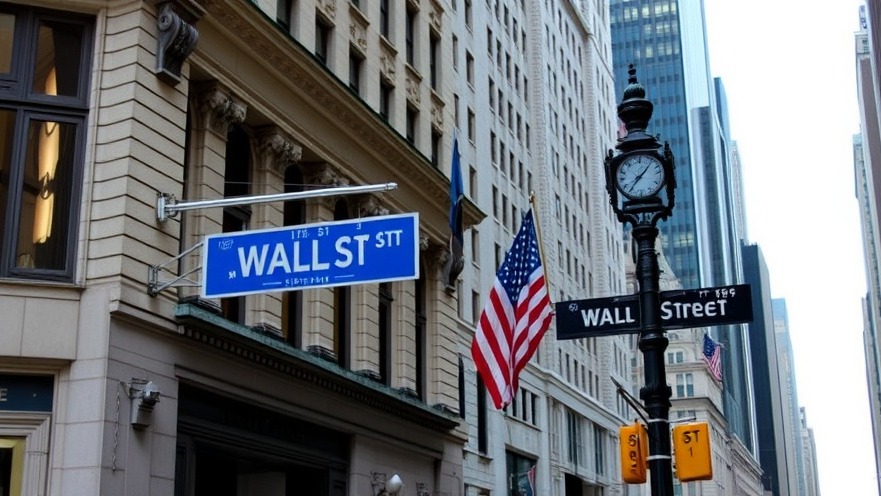
The Calm Before the Storm: A Shocking Turn on Wall Street
On what began as a seemingly typical trading day, Wall Street endured a staggering jolt as President Donald Trump's unexpected tariff threats sent the stock market reeling. The once-peaceful months for investors were abruptly shattered on October 10, 2025, when Trump hinted at a potential "massive increase of tariffs" on Chinese imports, prompting the S&P 500 to plummet 2.7%, marking its worst day since April. As the Dow Jones Industrial Average fell by 878 points and the Nasdaq composite dipped by 3.6%, financial analysts were left scrambling to make sense of the market turmoil.
Understanding the Trigger: Tariffs and Tensions
Trump's threats stemmed from China's export restrictions on crucial materials known as rare earths—elements vital for producing everything from smartphones to electric vehicles. In a social media post, he claimed other countries were "extremely angry at this great trade hostility," a comment that raised eyebrows among investors already uneasy about the escalating tensions between the world's largest economies. Such ostensible remarks not only wreaked havoc on stock prices but also rekindled fears of a protracted trade war, significantly impacting global market sentiment.
The Bigger Picture: Market Dynamics at Play
The sudden drop highlighted mounting criticisms regarding the rapid ascent of U.S. stock prices. With the S&P 500 having surged nearly 35% since its lows back in April, many investors began to question whether this bull market was sustainable. Economic experts pointed out that for stock prices to align more favorably with corporate profitability, either stock prices must fall or corporate earnings must rise. This dilemma left many concerned about the overvaluation in key sectors, especially in burgeoning industries like artificial intelligence—echoing sentiments reminiscent of the dot-com bubble of 2000.
Broader Impacts: The Ripple Effect Beyond Tech
While major tech stocks like Nvidia and Apple took significant hits, the downturn spread across various sectors, affecting small-cap companies and oil prices. Levi Strauss, despite reporting better-than-expected profits, witnessed a 12.6% decline, largely attributed to heightened expectations following an impressive year-to-date surge of 42%. This raises a critical question: in a market characterized by volatility, how can businesses weather unforeseen economic storms?
Consumer Sentiment and Market Response: A Holistic View
Alongside corporate fears, consumer sentiment reflects broader economic discord. Reports from the University of Michigan displayed persistently low sentiment among U.S. consumers, tethered to issues like high inflation and job insecurity. This paints a narrative that speaks to the heart of what policymakers and business leaders must confront: the nexus of consumer behavior and investor confidence must be managed delicately to avoid a deeper economic slide.
Future Insights: Navigating Turbulent Waters Ahead
As the situation unfolds, investors and analysts alike are left wondering about the future of trade negotiations and the stability of global markets. Increased volatility not only demands close monitoring of geopolitical factors but also raises questions on the effectiveness of risk management strategies for asset allocation going forward. In this turbulent climate, stakeholders must be prepared for potential continued shifts reminiscent of the unpredictable nature of previous market downturns.
Trump’s remarks about potentially abandoning a meeting with Xi Jinping further complicate existing tensions, casting doubt on future dealings. What once seemed a path toward diplomatic engagement now appears fraught with uncertainty.
Call to Action: Stay Informed in Uncertain Times
As the landscape of U.S. news and national economics continues to evolve, staying informed is paramount. Regularly review trusted sources and analysis to equip yourself with the insights needed to navigate financial markets effectively.
Conclusion: A Time for Caution and Strategy
The rapid shift in Wall Street sentiment serves as a stark reminder of how quickly market tranquility can dissolve into chaos. As the world watches, critical questions will linger regarding economic strategies, trade practices, and consumer welfare. Investors are advised to remain vigilant, considering how international dynamics align with domestic market conditions to make informed decisions moving forward.
 Add Element
Add Element  Add Row
Add Row 



Write A Comment